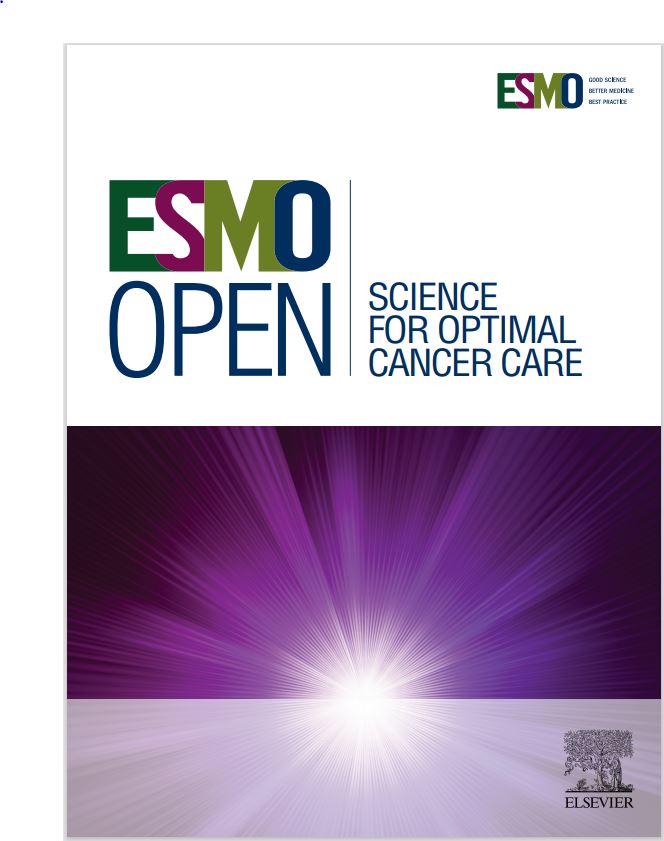Clinical characteristics and prognosis of pulmonary lymphoepithelioma-like carcinoma: a multicenter cohort study of 1106 cases
IF 8.3
2区 医学
Q1 ONCOLOGY
引用次数: 0
Abstract
Background
Pulmonary lymphoepithelioma-like carcinoma (PLELC) is a rare form of squamous lung cancer with clinical features that have conflicting findings from different studies. Meanwhile, the survival time, pattern of failure after treatment, and independent prognostic factors of these patients need to be further confirmed by large-sample studies, and whether their treatment regimens need to be different from those of squamous lung cancer remains unknown.
Patients and methods
Patients with PLELC diagnosed by pathology from January 2009 to December 2023 at four medical centers in China were retrospectively analyzed.
Results
A total of 1106 patients with PLELC were enrolled in the study. Of these patients, 0.3% (3/1106) had brain metastasis, and 71.6% (176/204) tested positive for programmed death-ligand 1 (PD-L1). The 2-year overall survival (OS) rates of stage I, II, III, and IV were 99.4%, 97.7%, 92.7%, and 70.4%, respectively, and the 5-year OS rates were 94.8%, 88.7%, 70.6%, and 37.8%, respectively. cTNM (clinical tumor–node–metastasis) stage and baseline Epstein–Barr virus (EBV) DNA level were independent prognostic factors for both PFS and OS in PLELC patients. No statistically significant differences in progression-free survival (PFS) or OS were observed between surgery alone and surgery with adjuvant therapy in stage I and II patients or between chemoradiotherapy and combined surgery–radiotherapy in stage IIIA and IIIB patients. In stage IV patients, chemoimmunotherapy appears to have longer PFS and OS than chemotherapy alone.
Conclusions
PLELC patients, with rare brain metastasis and high PD-L1 positivity, show favorable prognosis, but further research is needed to refine optimal treatment strategies for PLELC.
1106例肺淋巴上皮瘤样癌的临床特征及预后:一项多中心队列研究
肺淋巴上皮瘤样癌(PLELC)是一种罕见的鳞状肺癌,其临床特征在不同的研究中有相互矛盾的发现。同时,这些患者的生存时间、治疗后失败模式、独立预后因素等有待大样本研究进一步证实,其治疗方案是否需要与鳞状肺癌的治疗方案有所区别尚不清楚。患者和方法回顾性分析2009年1月至2023年12月中国4个医疗中心经病理诊断的PLELC患者。结果共纳入1106例PLELC患者。在这些患者中,0.3%(3/1106)有脑转移,71.6%(176/204)的程序性死亡配体1 (PD-L1)阳性。I期、II期、III期和IV期的2年总生存率(OS)分别为99.4%、97.7%、92.7%和70.4%,5年OS分别为94.8%、88.7%、70.6%和37.8%。cTNM(临床肿瘤-淋巴结-转移)分期和基线eb病毒(EBV) DNA水平是PLELC患者PFS和OS的独立预后因素。在I期和II期患者中,单纯手术与辅助治疗的无进展生存期(PFS)或OS,以及在IIIA期和IIIB期患者中,放化疗与手术-放疗联合治疗的无进展生存期(PFS)或OS无统计学差异。在IV期患者中,化疗免疫治疗似乎比单独化疗有更长的PFS和OS。结论PLELC患者脑转移罕见,PD-L1高阳性,预后良好,但需要进一步研究完善PLELC的最佳治疗策略。
本文章由计算机程序翻译,如有差异,请以英文原文为准。
求助全文
约1分钟内获得全文
求助全文
来源期刊

ESMO Open
Medicine-Oncology
CiteScore
11.70
自引率
2.70%
发文量
255
审稿时长
10 weeks
期刊介绍:
ESMO Open is the online-only, open access journal of the European Society for Medical Oncology (ESMO). It is a peer-reviewed publication dedicated to sharing high-quality medical research and educational materials from various fields of oncology. The journal specifically focuses on showcasing innovative clinical and translational cancer research.
ESMO Open aims to publish a wide range of research articles covering all aspects of oncology, including experimental studies, translational research, diagnostic advancements, and therapeutic approaches. The content of the journal includes original research articles, insightful reviews, thought-provoking editorials, and correspondence. Moreover, the journal warmly welcomes the submission of phase I trials and meta-analyses. It also showcases reviews from significant ESMO conferences and meetings, as well as publishes important position statements on behalf of ESMO.
Overall, ESMO Open offers a platform for scientists, clinicians, and researchers in the field of oncology to share their valuable insights and contribute to advancing the understanding and treatment of cancer. The journal serves as a source of up-to-date information and fosters collaboration within the oncology community.
 求助内容:
求助内容: 应助结果提醒方式:
应助结果提醒方式:


